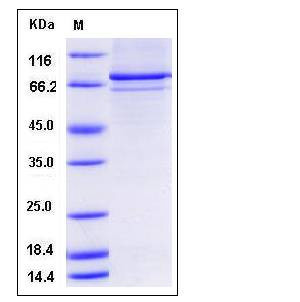Human MAPKAPK5 Protein (His & GST Tag)
MAPKAP-K5,MK-5,MK5,PRAK
- 100ug (NPP4072) Please inquiry
| Catalog Number | P13655-H20B |
|---|---|
| Organism Species | Human |
| Host | Baculovirus-Insect Cells |
| Synonyms | MAPKAP-K5,MK-5,MK5,PRAK |
| Molecular Weight | The recombinant human MAPKAPK5/GST chimera consists of 708 amino acids and has a calculated molecular mass of 82 KDa. It migrates as an approximately 75KDa band in SDS-PAGE under reducing conditions. |
| predicted N | Met |
| SDS-PAGE |  |
| Purity | > 76 % as determined by SDS-PAGE |
| Protein Construction | A DNA sequence encoding the human MAPKAPK5 isoform 1 (NP_003659.2) (Met 1-Gln 471) was fused with the N-terminal polyhistidine-tagged GST tag at the N-terminus. |
| Bio-activity | Kinase activity untested |
| Research Area | Cancer |Oncoprotein & suppressor & biomarker |Tumor suppressor |Other in Tumor suppressor |
| Formulation | Supplied as sterile 20mM Tris, 500mM NaCl, pH 8.0, 10% glycerol 1. Normally 5 % - 8 % trehalose and mannitol are added as protectants before lyophilization. Specific concentrations are included in the hardcopy of COA. |
| Background | MAPKAPK5 contains 1 protein kinase domain and belongs to the protein kinase superfamily, CAMK Ser/Thr protein kinase family. MAPKAPK5 has significant sequence homology to mitogen-activated protein kinase (MAPK)-activated protein kinase (MAPKAPK). It is widely distributed. MAPKAPK5 can be phosphorylated by extracellular-regulated kinase (ERK), and p38 kinase but not by c-jun N-terminal kinase (JNK)in vitro.Recombinant GST-MAPKAPK5 protein can phosphorylate a peptide derived from the regulatory light chain of myosin II. Phosphorylation of MAPKAPK5 by ERK and p38 kinase increased its activity by 9 and 15 fold respectively. Taken together, these data suggest that MAPKAPK5 is a novelin vitrosubstrate for ERK and p38 kinase. In response to cellular stress and proinflammatory cytokines, this kinase is activated through its phosphorylation by MAP kinases including MAPK1/ERK, MAPK14/p38-alpha, and MAPK11/p38-beta. MAPKAPK5 also mediates stress-induced small heat shock protein 27 phosphorylation. |
| Reference |
